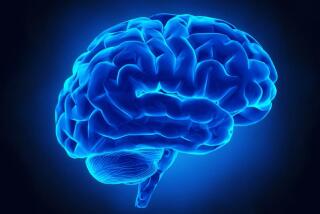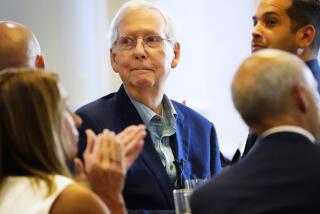Henry M. dies at 82; victim of brain surgery accident offered doctors key insights into memory
- Share via
For 55 years, he was known to the world at large only as HM or Henry M., the survivor of brain surgery that went catastrophically wrong, leaving him with a form of amnesia that prevented him from collecting any new memories and living in a pre-1953 world.
But when he died Dec. 2 of respiratory failure at a nursing home in Windsor Locks, Conn., his tightly guarded identity was finally revealed to the world. His name was Henry Gustav Molaison and he was 82.
The ill-conceived surgery was a personal disaster, but it was a major boon to the scientific community, providing researchers with the first window into how and where memories are formed in the brain.
Over the years, more than 100 different researchers studied his memory processes, publishing their insights in dozens of scientific papers.
“He is the most dramatic example of a patient who tragically became an experiment of nature,” physiologist and Nobel laureate Eric Kandel of Columbia University said some years ago. “That single case enlightened a whole body of knowledge.”
At the age of 9, HM struck his head on the pavement when he was run down by a bicycle rider near his home in rural Hartford County, Conn. He soon began having epileptic seizures and researchers were never sure whether it was this accident or a family history of epilepsy that caused his symptoms.
By the time he was 27, HM was having as many as 10 daily seizures and severe seizures at least once a week, blacking out and suffering severe convulsions that prevented him from working at his job repairing motors.
In 1953, Dr. William Beecher Scoville, a noted neurosurgeon at Hartford Hospital who had refined many of the techniques used in lobotomies, decided that he might be able to help HM surgically.
As HM lay awake on an operating table on the first day of September, Scoville inserted a metal tube deep into his brain and suctioned out two finger-sized pieces of tissue from the hippocampus, which was not then known to participate in memory formation and storage.
The operation was a partial success. HM’s major seizures were reduced to an average of about two per year.
But the side effects were unfortunate and unforeseen. HM developed what is known as severe anterograde amnesia, the inability to remember anything for more than a few seconds or minutes. Events in the days before his surgery also were forgotten -- a condition known as retrograde amnesia -- but he remembered much of his earlier life.
Conscience-stricken by what he had done, Scoville -- who later cautioned other surgeons against repeating his mistake -- contacted Dr. Wilder Penfield of McGill University in Montreal, who had studied memory problems in two other patients.
Penfield’s colleague Dr. Brenda Milner began studying HM, taking the night train from Montreal to meet with him and administer a variety of neurological and memory tests. Neurobiologist Suzanne Corkin of the Massachusetts Institute of Technology also began studying him, establishing a working relationship that lasted until his death.
But the researchers would have to reintroduce themselves every day they visited him. Eventually, HM seemed to retain some memory of Corkin. “He thought he knew me from high school,” she frequently said.
One of the first things they learned was that intelligence and memory formation were different functions. Even though HM’s ability to form new memories was virtually completely gone, his intelligence remained normal. He could carry on logical and comprehensible conversations and could even solve crossword puzzles, a hobby that he practiced all his life.
In a seminal paper in 1962, Milner demonstrated that there are at least two types of memory formation in the brain: what are now called declarative memory and motor learning or muscle memory.
Declarative memory, which is now known to operate primarily in the hippocampus, involves the recognition of faces, names and experiences.
Motor learning, which operates elsewhere in the brain and is largely subconscious, involves learned skills like riding a bike or bowling.
Milner demonstrated the difference by having HM learn how to draw a complicated figure while looking at it in a mirror -- a tricky task that he was able to perform successfully.
When he was asked at later times to repeat the process, he did not remember his earlier efforts, but it became progressively easier for him to learn how to do it, indicating that his muscle memory was functioning.
Milner later recalled that he said, after one of the trials, “Huh, this was easier than I thought it would be.”
Studies of HM also provided new information about spatial learning. If you asked him where he lived, he was likely to give you the address of the house where he lived before his surgery. But if you asked him to draw a detailed map of the layout of the house where he lived, he could do so.
Researchers concluded that this knowledge was gained subconsciously as he walked through the house carrying out his everyday activities.
Evidence also emerged of a similar ability with words. When researchers presented him with a list of words, such as “pancake, bicycle and bazooka,” he would quickly forget them. But if he was later asked to name a weapon, he was likely to say “bazooka,” neurobiologist John Gabrieli of Stanford University reported.
“And then he says, ‘Why, that’s an odd weapon. I wonder why I picked that one?’ ” Gabrieli said.
Details of Henry Molaison’s early life are scanty. His father was an electrician who moved from Louisiana to Hartford in the 1920s. Henry was born there on Feb. 26,1926.
He remembered roller-skating, a hike along the Mohawk trail and shooting his father’s gun in the woods, but he didn’t remember that his parents were dead unless he was coached.
Researchers noted, however, that his memories seemed flat and repetitive, and were not rich in detail.
After the disastrous surgery, he lived with his parents until their deaths, then with another relative. In 1980, he moved into the nursing home where he eventually died.
Molaison was a genial and meek man, eager to please, who cooperated fully with all the researchers who came to study him. No one knows if that was an inborn trait, the result of his upbringing or the aftermath of his accident.
Corkin is at work on a book about Molaison titled “A Lifetime Without Memory.” After he died Tuesday evening, researchers spent most of the night taking exhaustive MRI images of his brain, data that will help them interpret their earlier studies. She has also arranged for his brain to be preserved, like Einstein’s, for future study.
Molaison left no survivors.
Maugh is a Times staff writer






